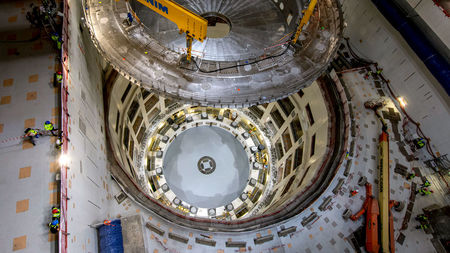Cranes lift ITER’s cryostat base into the tokamak pit to begin reactor assembly.
ITER Organization
The $25 billion ITER project, which aims to build the world’s largest fusion reactor and finally demonstrate that melding together hydrogen nuclei is a viable energy source, passed a major milestone today as construction crews lifted the first major piece of the reactor, known as a tokamak, into place.
Over 2 days, a crew of about 200 carefully lifted the cryostat base, a steel dish big enough to fill a baseball diamond and weighing as much as a giant redwood tree, into the tokamak pit near Cadarache in France. The cryostat base—the single largest and heaviest tokamak component—is the bottom section of a huge metal can that will eventually contain the rest of the reactor, including the vacuum vessel, huge superconducting magnets, and cooling systems. The ITER team is racing to have all of ITER’s major components on site by the end of 2021, in order to meet a December 2025 deadline for switching on the massive machine.
ITER has been a long time in gestation. Originally dreamt up in the 1980s, it was inaugurated as an international project based in France in 2007 and now has seven partners: China, the European Union, India, Japan, South Korea, Russia, and the United States. Projected at the time to be complete in 2016 at a cost of $11 billion, a thorough review…



